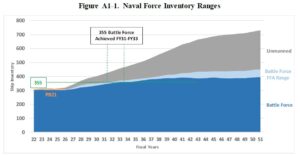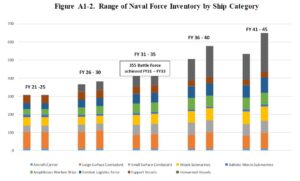The Navy finally released its 30-year shipbuilding plan 10 months late, mapping out plans to massively increase the fleet to reach 355 manned ships within a decade and pushing past 400 ships by the 2050s.
According to the plan, the service is planning on spending $147 billion from fiscal year 2022 to 2026 to procure 82 more ships, not counting unmanned vessels.

Notably, by fiscal year (FY) 2025, the Navy plans to buy four Large Unmanned Surface Vessels per year, build three attack submarines per year, add a second shipyard for frigate production to boost procurement to four ships per year, build three Light Amphibious Warships (LAW) per year, and retire about half of the cruiser fleet.
This is a large increase over the fiscal year 2021 budget request documents that outlined plans to procure 44 more ships over the incoming five-year FY ’21-25 Future Years Defense program (FYDP). The previous plan was expected to cost nearly $103 billion.
In addition to the regular vessel FYDP plans, by FY ’26 the Navy is planning to have 21 unmanned platforms: 1 Medium Unmanned Surface Vessel, eight Extra Large Unmanned Undersea Vehicles, and 12 Large Unmanned Surface Vessels.
Former Secretary of Defense Mark Esper first outlined plans for a 500-ship fleet within decades, called Battle Force 2045, earlier this year (Defense Daily, Oct. 6).
The shipbuilding plan projects the Navy increasing its battle force inventory from 305 in DY ’22 to 403 by FY ’45 before dropping below 400 for several years before rising again to 405 by FY ’51.
Overall, by FY ’45 the plan projects a force consisting of 11 carriers, nine large deck amphibious ships, 57 other amphibious warfare ships, 74 large surface combatants, 66 small surface combatants, 72 attack submarines/large payload submarines, 12 ballistic missile submarines, 69 combat logistics force ships, 33 support vessels, 119 unmanned surface vessels, and 24 unmanned undersea vessels.
The aircraft carrier inventory is expected to average 11 ships into the 2040s when it may dip closer to 9-10 while large surface combatants like DDG-51 destroyers are set to rise from 91 to 101 by 2029 before lowering to 74 ships by the early 2050s.
However, the plan calls for a large increase in small surface combatants, comprising Littoral Combat Ships and frigates, as well as attack submarines, amphibious warfare ships, and the combat logistics force.
The Navy projects 34 small surface combatants in FY ’22 but that rises to 71 by FY ’40 before settling at 66 by FY ’45. This largely results from an increase in annual production of Constellation-class (FFG-62) frigates.
The plan said it makes investments in FY ‘22 in long-lead time material and the “stand up of a ‘follow yard’ in FY ‘2023 to increase FFG 62 production to three ships in FY ‘2023 and to four ships by FY2025.”
The Navy argued larger small surface combatant numbers will allow the services to reduce large surface combatants while maintaining a more distributed force.
According to the plan, while large surface combatants like the Arleigh Burke-class DDG-51 Flight III destroyers and planned Future Surface Combatant are “key to Sea Denial and Sea Control Missions,” larger numbers of smaller combatants like the frigates “enable more efficient distribution of missions across the surface fleet, freeing up more capable assets (CGs and DDGs) for critical high-end missions.”
The future naval force study that informed the shipbuilding plan “indicated that growing the small surface combatant force enables reductions in the quantity of large surface combatants while yielding a more distributed and lethal force,” the report continued.
The shipbuilding plan aims for building three attack submarines (SSNs) per year while also conducting Columbia-class ballistic missile submarine serial production, something the industrial base has never done.
“Maintaining our undersea advantage is a priority for the Navy. We are in the process of assessing the industrial base capability to continue delivering three SSNs per year past FY ’26 during Columbia serial production. The post-FYDP SSN profile will continue to be reviewed and updated in subsequent plans as the industrial base assessments are refined with the goal of three SSNs per year, if affordable and supportable by the industrial base,” the plan said.
The plan expects to increase the attack submarine force from 52 in FY ’22 to 79 by FY ‘51

“I believe we have a body of work that has defined the requirement as best we understand it for the naval force we need to be part of the joint force,” a senior Navy official told reporters today.
“We have acquisition plans to be able to deliver that force, and then we have to resources identified and allocated to finance that at this point in time. I am very comfortable that we have all of those aligned and synchronized in a way that we have not had in the past with what I believe are reasonable future budget assumptions that are executable,” the official added.
The official also noted that “we need to build the industrial base to deliver what the nation needs, not meter what the nation can do based on today’s industrial base. There is capacity available, that doesn’t mean it’s not going to take investment.”
The Navy official argued this plan, over previous shipbuilding plans, has the Navy “making targeted and large investments to build the base we need, not just live with the base we have. So there is a large investment in the attack submarine industrial base, north of a billion dollars, $1.7 billion in here, to help get us facilitized, both at the supplier level and then at the shipyard level to enable us to then deliver at that increased production rate.”
The official underscored the plan has funds in FY ’22 to stand up the second frigate shipyard “so we get the frigate program similar to DDG-51 where we have multiple yards that can deliver on that ship.”
Various Navy officials telegraphed some of these moves in recent months, following Esper’s Battle Force 2045 announcement.
The Navy awarded the initial contract for the first 10 of 20 planned Constellation-class frigates earlier in 2020. Then in October, National Security Adviser Robert O’Brien said the Navy needs to build two to four new frigates per year and hinted a second shipyard would be needed to accomplish that (Defense Daily, Oct. 30).
That month, Secretary of the Navy Kenneth Braithwaite confirmed plans to procure more than 20 frigates and suggested selling the hull to international allies akin to the F-35 (Defense Daily, Oct. 29).
Last month, program executive official for submarines Rear Adm. David Goggins said the Navy was studying how to ramp up to three attack submarines per year but they are confident it is possible if enacted. However, he noted any expansion will not come at the expense of the Columbia-class nuclear-armed ballistic missile submarine program (Defense Daily, Nov. 20).
However, last week, the Chairman of the Joint Chiefs of Staff offered a realistic assessment of these plans, calling them more like aspirations than clearly planned objectives (Defense Daily, Dec. 3).
He admitted critics may be right that the numbers in these plans are arbitrary and are not affordable, but it is “an aim point, that’s a march objective… You’re going to have to have a much larger fleet than we have today if we’re serious about great power competition and deterring great power war and you’re serious about having dominant capability over something like China.”
This 30-year shipbuilding plan was delivered so late due to Esper directing Deputy Secretary of Defense David Norquist to conduct a study on the Navy future force plans to integrate it with the Navy’s force structure assessment and overall defense posture (Defense Daily, Sept. 11).